Chiral Surfaces
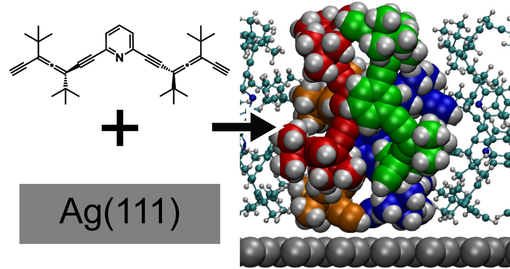
Morphological Self-assembly of Enantionpure Allenes for Upstanding Chiral Architectures at Interfaces
Chiral surfaces have been intensively investigated in the last years due to their great potential for surface sensing technology. However, the very weak or absent chiroptical properties of the molecules commonly used for the construction of chiral surfaces hampers their exploitation for real devices. In this work, multifunctional chiral allenes are for the first time explored for the construction of surface-confined nanoarchitectures. Gas-phase characterization, low-temperature scanning tunneling microscopy and molecular-dynamics simulations reveal that the dominance of molecule–molecule over molecule–substrate interactions leads to regular diastereomeric domains of up-standing chiral architectures (UCAs) with the optically active units being largely decoupled from the substrate. The outstanding chiroptical responses presented by such allene derivatives along with the opportunity to further functionalization via the terminal alkyne exposed on top of the monolayer-thin architectures make such UCAs promising key ingredients for chirality sensing applications.
Chiral surfaces have been intensively investigated in the last years due to their great potential for surface sensing technology. However, the very weak or absent chiroptical properties of the molecules commonly used for the construction of chiral surfaces hampers their exploitation for real devices. In this work, multifunctional chiral allenes are for the first time explored for the construction of surface-confined nanoarchitectures. Gas-phase characterization, low-temperature scanning tunneling microscopy and molecular-dynamics simulations reveal that the dominance of molecule–molecule over molecule–substrate interactions leads to regular diastereomeric domains of up-standing chiral architectures (UCAs) with the optically active units being largely decoupled from the substrate. The outstanding chiroptical responses presented by such allene derivatives along with the opportunity to further functionalization via the terminal alkyne exposed on top of the monolayer-thin architectures make such UCAs promising key ingredients for chirality sensing applications.
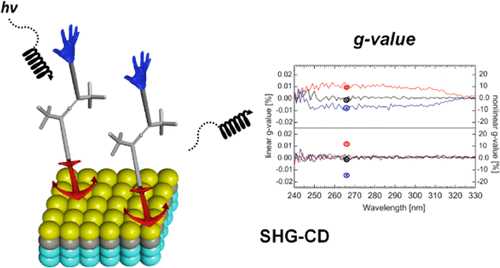
Device-compatible Chiroptical Surfaces through Self-assembly of Enantiopure Allenes
Chiroptical methods have been proven to be superior compared to their achiral counterparts for the structural elucidation of many compounds. To expand the use of chiroptical systems to everyday applications, the development of functional materials exhibiting intense chiroptical responses is essential. Particularly, tailored and robust interfaces compatible with standard device operation conditions are required. Herein, we present the design and synthesis of chiral allenes and their use for the functionalization of gold surfaces. The self-assembly results in a monolayer-thin room-temperature-stable upstanding chiral architecture as ascertained by ellipsometry, X-ray photoelectron spectroscopy, and near-edge X-ray absorption fine structure. Moreover, these nanostructures anchored to device-compatible substrates feature intense chiroptical second harmonic generation. Both straightforward preparation of the device-compatible interfaces along with their chiroptical nature provide major prospects for everyday applications.
Chiroptical methods have been proven to be superior compared to their achiral counterparts for the structural elucidation of many compounds. To expand the use of chiroptical systems to everyday applications, the development of functional materials exhibiting intense chiroptical responses is essential. Particularly, tailored and robust interfaces compatible with standard device operation conditions are required. Herein, we present the design and synthesis of chiral allenes and their use for the functionalization of gold surfaces. The self-assembly results in a monolayer-thin room-temperature-stable upstanding chiral architecture as ascertained by ellipsometry, X-ray photoelectron spectroscopy, and near-edge X-ray absorption fine structure. Moreover, these nanostructures anchored to device-compatible substrates feature intense chiroptical second harmonic generation. Both straightforward preparation of the device-compatible interfaces along with their chiroptical nature provide major prospects for everyday applications.
Chiral Nanotarticles
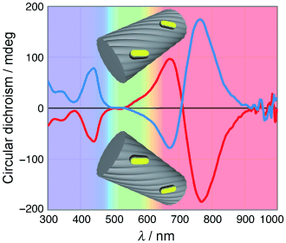
Chiral amplification has been often achieved with metal nanoparticles (NPs). The chiroptical activity of NPs may be of individual or collective origin. In collaboration with Prof L. Liz , we used gold nanorods (NRs) to obtain outstanding chiroptical responses.
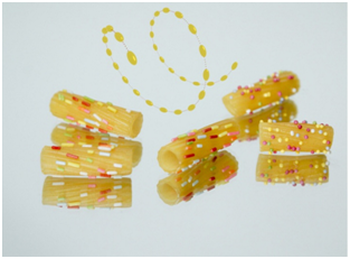
From individual to collective chirality in metal nanoparticles
Recent reports have illustrated the promising potential of chiral metal nanostructures, which exploit the characteristic localized surface plasmon resonance of metal colloids, to produce intense optical activity. In this article we review the concepts, synthetic methods, and theoretical predictions underlying the chirality of metal colloids with a particular emphasis on the size range of 10–100 nanometers. Collective chirality and the associated optical activity in nanoparticle assemblies is a promising alternative that has seen a few recent experimental demonstrations. We conclude with a perspective on chiral nanostructures built up from achiral anisotropic metal particles.
Recent reports have illustrated the promising potential of chiral metal nanostructures, which exploit the characteristic localized surface plasmon resonance of metal colloids, to produce intense optical activity. In this article we review the concepts, synthetic methods, and theoretical predictions underlying the chirality of metal colloids with a particular emphasis on the size range of 10–100 nanometers. Collective chirality and the associated optical activity in nanoparticle assemblies is a promising alternative that has seen a few recent experimental demonstrations. We conclude with a perspective on chiral nanostructures built up from achiral anisotropic metal particles.
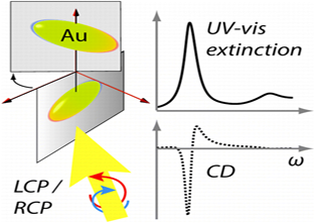
Theoretical investigation of the optical activity of a dimer of plasmonic nanoantennas
In this respect we continue on exploring collective chirality with plasmonic nanoparticles (NPs). On the other hand, we are also interested on the individual chirality. As an application of chiral allenophanes we will decorate them with thiol groups to enable their attachment to the NPs surface. Adsorption onto NPs may greatly amplify the optical activity of these novel chiral macromolecules.
Absolute Configuration Determination
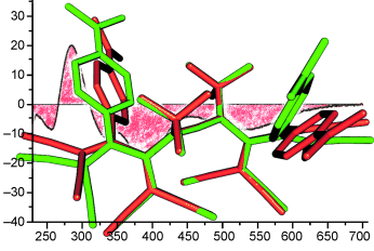
Conformational assignment
The mechanism of chiral induction in an optically pure 1,3-diethynylallene, from the central chiral allene moiety into directly adjacent TCBD chromophores, was confirmed and clarified. Only one low-energy conformer is found in calculations of the potential energy surface, which closely resembles the X-ray crystal structure. Simulations of the CD spectrum by time-dependent DFT showed a total agreement (see picture), in terms of position and sign, for all Cotton effects when compared to the experimental spectrum.
The mechanism of chiral induction in an optically pure 1,3-diethynylallene, from the central chiral allene moiety into directly adjacent TCBD chromophores, was confirmed and clarified. Only one low-energy conformer is found in calculations of the potential energy surface, which closely resembles the X-ray crystal structure. Simulations of the CD spectrum by time-dependent DFT showed a total agreement (see picture), in terms of position and sign, for all Cotton effects when compared to the experimental spectrum.
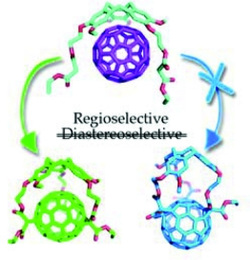
Triple Bingel addition of enantiomerically pure cyclotriveratrylene-tethered trimalonates to C60 was reinvestigated with regard to the regio- and diastereoselectivity. Electronic and vibrational circular dichroism studies showed that the addition proceeds regioselectively, yielding trans -3, trans -3, trans -3 tris-adducts, contrary to earlier reports.
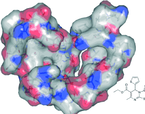
A thiazolopyrimidine derivative resulting from high-throughput screening was found to be active toward 2-methylerythritol 2,4-cyclodiphosphate synthase (IspF) from Mycobacterium tuberculosis and Plasmodium falciparum , with respective IC 50 values of 6.1±0.8 and 9.6±1.5 µ M . Some of the prepared derivatives exhibit weak in vitro activity against the protozoan parasite P. falciparum.
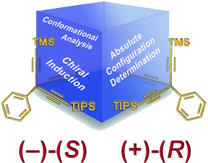
Both enantiomers of an optically active trialkynyl(phenyl)methane (the key building blocks in the construction of a stable expanded cubane) have been prepared. The strategy involved the resolution of a racemic intermediate by means of HPLC on a chiral stationary phase. The absolute configuration of this intermediate was unambiguously assigned by using vibrational circular dichroism (VCD) and optical rotatory dispersion (ORD), in combination with density functional theory (DFT) calculations.
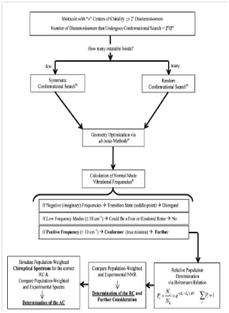
This minireview is addressed to readers with a background in basic organic chemistry and spectroscopy, but without a specific knowledge of NMR, ECD, VCD and ORD. Herein we summarize the role of quantum mechanical ab initio prediction of spectral properties in NMR and chiroptical spectroscopies. Illustrative examples of the application of prediction of chemical shifts and scalar couplings to the determination of chemical constitution and relative configurations of natural products are presented. Once the relative configuration is determined, the absolute configuration can be established with the help of ECD, VCD and ORD spectroscopies assisted by quantum mechanical prediction of the corresponding spectra. The scope, limitations and advantages of these chiroptical spectroscopies are presented, in order to help the reader in choosing a suitable combination of ab initio and spectroscopic tools when cing a particular problem.
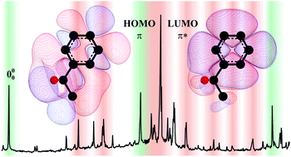
Chiroptical Inversion for Isolated Vibronic Transitions of Supersonic Beam-Cooled Molecules
Circular dichroism-resonance-enhanced multiphoton ionization (CD-REMPI) was used for CD measurements on several single vibronic transitions of supersonic beam-cooled (R)-(+)-1-phenylethanol. Due to the low molecular densities within a supersonic beam and the expected small anisotropy factor of 1-phenylethanol in the permille region, the precision of the experimental method had to be significantly improved. Therefore, a single laser pulse evaluation combined with a twin-peak technique enabled within the used supersonic beam setup is presented. For the electronic transition S0 → S1 of (R)-(+)-1-phenylethanol (π → π* transition of the phenyl ring at 266 nm) ten different vibrational modes as well as the 000-transition were investigated with one-color (1 + 1) CD-REMPI. The results deliver new experimental insights on the influence of molecular vibrations on the anisotropy factor. TD-DFT theoretical predictions show how the angle between the electronic and magnetic transition dipole moments of the electronic transition can be modified by different vibrational modes, making even a flip of the sign of the anisotropy factor possible.
Circular dichroism-resonance-enhanced multiphoton ionization (CD-REMPI) was used for CD measurements on several single vibronic transitions of supersonic beam-cooled (R)-(+)-1-phenylethanol. Due to the low molecular densities within a supersonic beam and the expected small anisotropy factor of 1-phenylethanol in the permille region, the precision of the experimental method had to be significantly improved. Therefore, a single laser pulse evaluation combined with a twin-peak technique enabled within the used supersonic beam setup is presented. For the electronic transition S0 → S1 of (R)-(+)-1-phenylethanol (π → π* transition of the phenyl ring at 266 nm) ten different vibrational modes as well as the 000-transition were investigated with one-color (1 + 1) CD-REMPI. The results deliver new experimental insights on the influence of molecular vibrations on the anisotropy factor. TD-DFT theoretical predictions show how the angle between the electronic and magnetic transition dipole moments of the electronic transition can be modified by different vibrational modes, making even a flip of the sign of the anisotropy factor possible.
